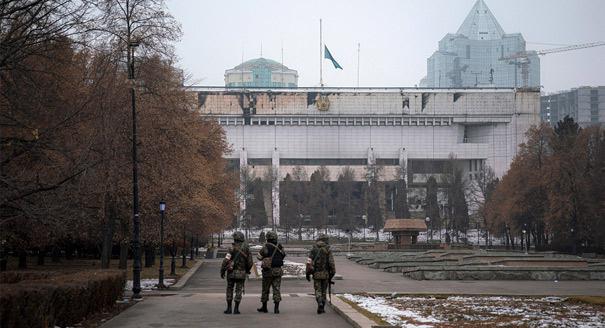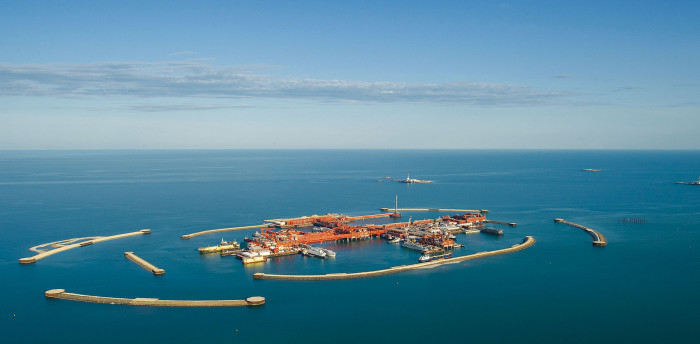
What are the lessons and the likely consequences of the recent crisis in Kazakhstan for the country itself, for Central Asia, and for Russia’s role in the region?
The violence that rocked Kazakhstan in early 2022 shocked the country and its neighbors, shattering Kazakhstan’s image as a stable country and derailing its post-Soviet trajectory. January’s events showed that Kazakhstan is not necessarily immune from the bottom-up political violence and fierce elite infighting that several of its neighbors have witnessed. As if the drama of Kazakhstan’s domestic turmoil was not enough, President Kassym-Jomart Tokayev’s request for a Russian-led Collective Security Treaty Organization (CSTO) intervention to help quell the violence represented a sea change in Kazakhstani and Russian foreign policy toward security in the region, taking the West by surprise.
The CSTO deployment in Kazakhstan was short-lived, but it provided an important circuit breaker. Tokayev’s request to Moscow for help was basically an admission that he was unable to control the situation. But it also appears to have been a clever ploy to outmaneuver his rivals, including the country’s longtime leader Nursultan Nazarbayev. In any event, the contrast with Nazarbayev, who had always kept a firm grip on the country’s politics without outside help, could not have been more striking.
Because of the normally opaque nature of Kazakhstani elite politics, a thorough account of what really happened is unlikely to emerge. The Tokayev government has claimed that the unrest was triggered by foreign actors, including alleged “terrorists,” but has offered no evidence to support this allegation. Nor is there any reason to believe Chinese and Russian assertions that the unrest was an attempt at a “color revolution” sponsored by the West: Washington was caught off guard, just like everyone else, and appeared hesitant and flat-footed in its response. Still, given what is known, what are the lessons and the likely consequences of this crisis for Kazakhstan, for Central Asia, and for Russia’s role in the region?
Nazarbayev Is Out
In retrospect, the critical turning point in Kazakhstani politics was the decision by then president Nazarbayev to initiate a gradual transfer of power to Tokayev, his hand-picked successor, in 2019. Tokayev had previously held a number of senior government posts, but was perceived as someone without a strong domestic political base. After twenty-nine years in the presidency, Nazarbayev assumed the title of “Elbasy,” or “leader of the nation,” and retained the chairmanship of the all-powerful Security Council and thus control of the security apparatus. For over two years, the tandem appeared to work, even if there were occasional signs of friction.
But the loosening of the reins by Nazarbayev and the appearance of duality of power at the top led to factionalism. The January street protests appear to have triggered elite clashes that led to the tandem’s collapse. Within just three days of the start of the unrest, Tokayev had forced Nazarbayev to relinquish chairmanship of the Security Council. He then fired the prime minister, the entire cabinet, and several senior Nazarbayev appointees from the security apparatus. (Since then, some ministers reportedly have been reappointed.)
The Nazarbayev family and its allies have long controlled the country’s most profitable natural resources and financial assets. Having sidelined Nazarbayev and several of his close political allies, Tokayev seems determined to establish control over economic power, too. He has already pushed out Nazarbayev’s family members from influential posts at a lobbying group, energy companies, and a lucrative recycling company. It was also recently reported that a charity foundation headed by Nazarbayev’s younger brother, Bolat, had donated $2.3 million to a fund established at Tokayev’s orders to combat socioeconomic problems following the unrest. In a populist move and to deflect blame for many of the country’s socioeconomic problems, Tokayev appears keen to relieve some wealthy insiders of power and prestige.
There have been other moves to strip Nazarbayev of his honorific titles. Tokayev signed off on the rubber-stamp parliament’s constitutional changes that removed Nazarbayev from several lifetime appointments, including as Chair of the People’s Assembly of Kazakhstan and head of the Security Council. An online petition has been launched to restore the name of the capital to Astana—it was renamed Nur-Sultan in honor of Nazarbayev after he stepped down as president in 2019—and many government officials are already calling the city simply “the capital.” There is likely more of this to come.
Nazarbayev deserves credit for finally recognizing it was time to go. In the aftermath of the crisis, possibly under duress, he gave a television address and announced his retirement from public life. However, the January unrest and violence have severely damaged his legacy. During the protests, he was the focus of public anger. Tokayev’s swift appeal for Russia to help stabilize the country also undercut a key Nazarbayev achievement: a three-decade record of Kazakhstan as an independent, sovereign nation. The future of Nazarbayev’s multi-vector foreign policy is now in question as Russia will no doubt seek to reap the benefits of its intervention. The crisis has also tarnished Kazakhstan’s investment climate, at least in the near term, though foreign energy and natural resource players will no doubt seek to protect their existing investments and keep an eye out for future opportunities.
The leadership change is unlikely to improve the lot of the Kazakhstani people or to address the deep and long-standing socioeconomic and political problems that were the root cause of the unrest. Elite factions’ maneuvering and jockeying for political or economic advantage are a huge potential source of distraction that will leave little time to address such problems. Meanwhile, the leadership’s lack of confidence and uncertain hold on power likely will incentivize it to crack down on domestic dissent, certainly a concern of many civil society activists and the West. Kazakhstan had previously enjoyed a reputation for having a slightly milder form of authoritarianism compared to some of its neighbors: a fact that had helped facilitate ties with Europe and the United States. Asking for Russian help also may turn out to be a political liability for Tokayev over the long term if it feeds nationalist sentiment, which is often directed against the former colonial power. In sum, the immediate crisis may be over, but Kazakhstan’s long-term stability is hardly assured.
Unstable Transitions
The crisis also highlights how headwinds from the global economy, the pandemic, and a carefully orchestrated leadership transition can bring unexpected destabilizing consequences for regimes that appear to have tight control on the reins of power. In Kazakhstan, the formal transition that began in 2019 was not the end, but the beginning of the leadership transition—one that initially appeared well-planned, but ended up quite messy.
Political stability in Eurasia is frequently illusive, with regimes often looking highly secure until suddenly they are not. Armenia, Georgia, Kyrgyzstan, and Ukraine have all suffered unexpected bouts of bottom-up instability that triggered leadership changes at the very top. Interestingly, all of these countries were semi-democratic at the time. Authoritarian Kazakhstan was similar to some extent in that the Nazarbayev regime aspired to show a lighter touch both at home and abroad.
By contrast, the transitions were smoother in highly authoritarian Uzbekistan and Turkmenistan, where new leaders had reaffirmed a strong grip and quickly sidelined all potential rivals. The comparison between the centralized transitions in Tashkent and Ashgabat and the more difficult ones in Nur-Sultan and Bishkek is likely not lost on the broader Eurasian region’s remaining autocrats.
Russia’s Wins
The Kremlin, like everyone else, was blindsided by the unrest in Kazakhstan. But three days after the protests started and just hours after they turned violent, it quickly capitalized on an opportunity to shore up its influence in a region growing more dependent on China. The CSTO’s peacekeeping deployment to Kazakhstan was the first instance of the Russian-dominated alliance acting to stabilize a member state. By intervening nimbly and decisively in Kazakhstan, Putin reinforced one of his favorite messages to fellow authoritarian leaders: I have your back. The CSTO intervention and prompt withdrawal of the Russian-led peacekeeping contingent illustrated the Kremlin’s ability to leverage local partners to reach a desired end state. Notwithstanding Russia’s ongoing military buildup along the Ukrainian border, it showed that it can walk and chew gum at the same time.
China initially stood on the sidelines, although it provided public support and political cover for the crackdown. Yet Tokayev announced on February 5 that Chinese President Xi Jinping would pay his fourth visit to Kazakhstan later this year, likely enhancing trade, investment, and diplomatic links between the two countries. By contrast, U.S. and European officials displayed little ability to guide events in a region from which they have largely retreated. At a moment of intense crisis and chaos, Western governments took their time, urged caution, preached nonviolence, and lectured autocrats about human rights. At the height of the crisis, U.S. Secretary of State Antony Blinken devoted part of his January 6 phone call with his Kazakhstani counterpart Mukhtar Tileuberdi to Ukraine: a pivot that suggests the United States prioritizes European security over that of Central Asia. Both Beijing and Moscow likely took note.
The contrast with how Russia and the CSTO responded to previous instances of state fragility was also remarkable. The Kremlin stood on the sidelines when political or ethnic instability rocked other CSTO members—Armenia, Kyrgyzstan, and Tajikistan—in 2020 and 2021. So what has changed? It is hard to overstate the fact that Kazakhstan is special to Russia. Thanks to its size, 7,600-kilometer land border with Russia, large economy, and vast natural resources, Kazakhstan is Russia’s most important neighbor after Belarus and Ukraine (both of which occupy geostrategic locations between Russia and NATO).
While the intervention in Kazakhstan was high profile, the actual Russian role on the ground was relatively low key and low risk, evidently designed more for its reputational effect than impact on the ground. Considering the Kremlin’s reluctance to get involved in previous crises, the unexpected intervention was too good an opportunity to shore up Russian clout in one of its most important neighbors to pass up. That raises the possibility that the CSTO operation could end up being a one-off. A repeat of Moscow stepping in to resolve other regional crises should not be taken for granted.
Still, the intervention showed that the Russian-dominated security alliance is not a paper tiger, as experts in the West have so often dismissed it. At a time when NATO is struggling to coordinate a collective response to renewed threats of Russian aggression against Ukraine and Moscow’s efforts to rewrite the European security architecture on its own terms, the Kremlin quickly coordinated (or coerced) a collective response from its allies. The intervention in Kazakhstan was a clear win for Putin. It created an image of Russia as a powerful, decisive, and effective force for stability in a region where those qualities are in short supply. Having lost ground to China in Central Asia over the past two decades, Russia was able to reestablish itself as a geopolitical actor and major force in the region thanks to the events in Kazakhstan. The West largely stood by and watched.
This article was published as part of the “Relaunching U.S.-Russia Dialogue on Global Challenges: The Role of the Next Generation” project, implemented in cooperation with the U.S. Embassy to Russia. The opinions, findings, and conclusions stated herein are those of the author and do not necessarily reflect those of the U.S. Embassy to Russia.
Original source of article: carnegiemoscow.org




